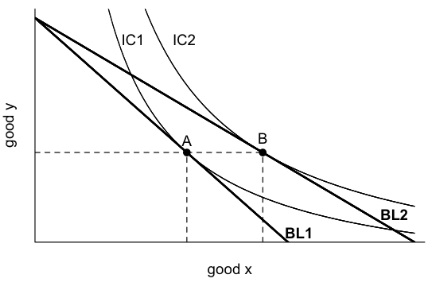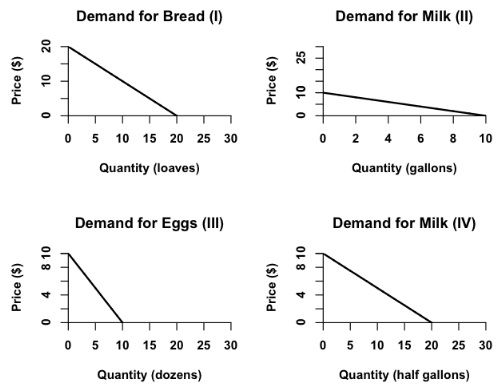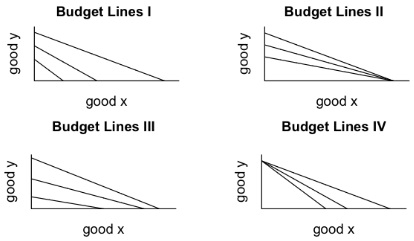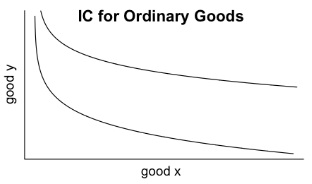Question 1. Which of the following is an incorrect representation of economic profit?
a.) TR - TC
b.) (P - ATC)*Q
c.) (P - AVC)*Q ± A FC
d.) (P - AVC)*Q ± FC
Question 2. In Xanadu , the market basket, which does not change from year to year, consists of only mushrooms and teapots. Using the following table, find the CPI for 2002 using 2000 as the base year and a 100 point scale.

a) 45/17 x 100
b) 20/17 x 100
c) 33/17 x 100
d) 35/17 x 100
Use the following information for the next two (2) questions.
Francis has an income of $10. In this world, there are only three goods: housing, bread, and steak. Francis has simple tastes. He considers one loaf of bread and one steak to be perfect substitutes. Francis always buys one unit of housing and he spends the rest of his money on bread or steak. Suppose housing costs $5 per unit, bread is $1 per loaf, and one steak costs $2.
Question 3. Given the above information, what is Francis' optimal bundle of housing, bread, and steak?
a.) 1 unit of housing, 1.67 loaves of bread, and 1.67 steaks
b.) 1 unit of housing, 0 loaves of bread, and 2.5 steaks
c.) 1 unit of housing, 3 loaves of bread, and 1 steak
d.) 1 unit of housing, 5 loaves of bread, and 0 steaks
Question 4. Now suppose that Francis' income is tied to inflation s o that though the nominal amount may vary, his real inflation - adjusted income will remain constant. Assume the market basket used in calculating the rate of inflation is constant and consists of 1 unit of housing, 1 loaf of bread, and 2 steaks. Suppose pri ces change so that now housing costs $10 per unit, bread $1 per loaf, and steak costs $4.50. Given his inflation - adjusted income, is Francis better or worse off than he was initially? Why?
a.) Francis has no change in his utility since his purchasing power has been kept constant.
b.) Francis is better off because the income adjustment that occurs based upon the cost ofthis set market basket is greater than the change in the price of Francis' initial preferred bundle.
c.) Francis is worse off since the market basket used to compute the inflation rate does not match Francis' initial prefered bundle.
d.) Francis is worse off since the income adjustment, based on the fixed market basket, will not account for the substitution effect between goods.
Question 5. Examine the graph b elow. The move from consumption choice A to choice B comes from a _________ in the price of good x. The substitution effect on good x will be __________.

a.) increase, zero
b.) decrease, positive
c.) decrease, negative
d.) decrease, zero
Question 6. A perfectly competitive firm finds that at its current output, MR > MC and P > ATC. Assume a linear marginal cost equation. Given this information, then this firm should
a.) not change its level of output.
b.) increase its level of output.
c.) reduce its level of output.
d.) shut down entirely.
Question 7 . The arc - elasticity between two poi nts A and B on a demand curve is equal to one. Suppose you know that point A is (Q, P) = (30, 1). Which of the following points must be point B?
a.) (Q, P) = (3, 10 )
b.) (Q, P) = (10, 4)
c.) (Q, P) = (10, 5)
d.) (Q, P) = (29, 2 )
Use the following information for the next three (3) questions.
In a perfectly competitive industry, each firm has the following total and marginal cost curves:
TC = 3q2 + q + 12
MC = 6q + 1
The market demand curve is: P = 17 - Q
Question 8 . In the short run, there are two identical firms. What is the equilibrium short run price?
a.) $5
b.) $4
c.) $13
d.) $12
Question 9. What is the profit of each firm in the short run?
a.) $2
b.) $0
c.) $ 24
d.) $12
Question 10. How many firms will serve this perfectly competitive market in the long run?
a.) 4 firms
b.) 2 firms
c.) 3 firms
d.) 1 firm
Question 11. Carefully examine the demand curves shown below. If you were to pick a price and compare the price elasticity of demand across these demand curves at that price, which of them would have the same elasticity? Base your answer u pon the point elasticity concept. Refer to each demand curve by the Roman numerals in parentheses

a.) Demand curves II and IV have the same price elasticity of demand at a particular price.
b.) Demand curves I and IV have the same price elasticity of demand at a particular price.
c.) Demand curves II, III, and IV have the same price elasticity of demand at a particular price.
d.) Demand curves II and III have the same price elasticity of demand at a particular price.
Question 12. For the nation of Never Neverland, the market basket consists of 1 pound of pixy dust, 2 liters of rainbow drops, and 2 tick - tock nuts. One pe culiar thing about this nation is that the economy does not experience inflation nor does it experience deflation. Using the information in the table below, figure out the nominal price of pixy dust in 2013. Use 2012 as the base year.

a.) $5
b.) $2
c.) $3
d.) $15
Question 13. Margo has a monopoly on the market for notebooks. We know the costs she faces and the demand curve equation. P is the price in dollars ($) and Q is the quantity of notebooks.
Demand: P = (3/Q) + 1
Total Cost: TC = 1 + Q
What's the highest profit attainable by Margo? (Hint: On this problem it will be helpful to 'think' about alternative approaches before you 'pluge in'.)
a.) $1
b.) Margo can make infinite profit.
c.) $2
d.) Between $3 and $4
Question 14. Which of these is not an assumption of perfect competition?
a.) Perfect knowledge
b.) Firms make zero economic profit
c.) Individual buyers cannot affect the price of the good
d.) Identical products are produced by the firms in the industry
Question 15. Which of these quotes, along with the provided context, indicates the most inelastic supply of labor at the relevant margin? Hint: Recall that 'inelastic' implies that the quantity is not particularly responsive to changes in price while 'eleastic' implies that the quantity is reposive to change in price.
I. "I'm not playing basketvball ...to make money...I just want to be happy doing what I love to do." - Allen Iverson (professional basketball player) on looking to join a team/employer.
II. "I'm just trying to feed my family." - Terrell Owens (professional football player) insisting on a better wage contract.
III. "First of all, the money was too good." - Brett Favre (professional football player) on why he worked another season in the National Football League.
IV. "I wanted to be the highest-paid player in the game." - Wayne Gretzky (professional hockey player) on why he left Edmonton Oilers (a team/employer) for theLos Angels Kings (a different team/employer).
a.) I
b.) II, III, and IV
c.) II I
d.) II
Question 16 . Given the following total cost function, derive the fixed cost. TC = 5/(q+1) + 5 + 5q + q2
a.) $4
b.) $5
c.) $8
d.) $10
Question 17 . Garrison derives utility from pairs of red shoes (x) and lutefisk (y). The marginal utility of a pair of red shoes is MUx = 1/x. The marginal utility of a unit of lutefisk is MUy = 1. Garrison has an income of $2. Suppose a pair of red shoes costs $1, and a unit of lutefisk costs $1. Which of these bundles should Garrison consume?
a.) 1 pairs of red shoes and 0 units of lutefisk
b.) 0 pairs of red shoes and 2 units of lutefisk
c.) 1 pair of red shoes and 1 unit of lutefisk
d.) 0.5 pairs of red shoes and 1 unit of lutefisk
Question 18. Many income tax deductions provide tax relief according to a citizen's tax bracket. This kind of tax relief implies that as a person's income rises, the value of the tax deduction increases. Suppose we consider a single tax deduction for good x wher e this tax deduction effectively makes good x cheaper for those in higher tax brackets (i.e. consumers with more income). Which of these graphs represents this concept best, holding everything else constant?

a.) Budget Lines IV
b.) Budget Lines III
c.) Budget Lines II
d.) Budget Lines I
Use the following information for the next four (4) questions. In the small nation of Wonderland, there is a tea market. The domestic demand, supply, and world price are described below. P is the price in dollars and Q is the quantity of tea.
Domestic demand: P = 10 ± Q
Domestic supply: P = Q
World price: P = 219
Question 19. What is the value of consumer surplus in Wonderland when the tea market there is closed to trade?
a.) CS = $5
b.) CS = $30
c.) CS = $6.25
d.) CS = $12.50
Question 20. If the market for tea in Wonderland opens to free trade, how many units of tea will be imported?
a.) 2 units
b.) 8 units
c.) 4 units
d.) 6 units
Question 21. Suppose the market for tea in Wonderland is open to trade but that the government of Wonderland simultaneously implements an import quota of 2 units of tea. How many sources of deadweight loss will there be? Describe the source(s) of deadweight loss.
a.) There is one source of deadweight loss: this deadweight loss is due to the tea being under - supplied in Wonderland once the import quota is implemented.
b.) There is one source of deadweight loss: this deadweight loss is due to domestic producers, being more inefficient than non - domestic producers, producing too much tea once the import quota is implemented.
c.) There are two sources of deadweight loss: the deadweight loss is due to the tea being under - supplied in Wonderland once the import quota is implemented and to domestic producers, being more inefficient than non - domestic producers, producing too much tea once the import quota is implemented.
d.) There are two sources of deadweight loss: the deadweight loss comes from consumers buying too little tea and domestic producers losing business because of the implementation of the import quota.
Question 22. Suppose the government changes the import quota to 10 units of imported tea. Which of the following statements is true given this change in the import quota and holding everyth ing else constant?
a.) License holder revenue will increase.
b.) There will be no deadweight loss.
c.) Wonderland will begin to export tea.
d.) Domestic producer surplus will increase.
Question 23. Which of these statements correctly differentiates cardinal and ordinal utility theory?
a.) Cardinal utility gives meaning to the difference in the util value attached to each bundle of goods.
b.) Only cardinal utility can be represented by a utility function.
c.) Cardinal utility does not allow us to rank choices from most to least preferred.
d.) Ordinal utility does not allow us to rank choices from most to least preferred.
Question 24 . We usually work �with "bowl shaped" indifference curves. Those shown below are just one example. Which of the following statements does not give an accurate interpretation of the curvature of the indifference curve? That is, which of these statements is not related to the slope or the change in slope along an indifference curve?

a.) More of a good is always preferred.
b.) If a consumer is indifferent between two bundles, they will prefer the average of the two bundles to either of the original bundles.
c.) Goods have diminishing marginal utility.
d.) The two goods represented in indifference curve maps are always normal goods
Question 25. When Lucy operates a lemonade stand by herself she finds that she can produce 100 cups of lemonade per hour. She finds that if she hires her friend Charlie and they both operate the lemonade stand, they will together produce 120 cups of lemonade per hour all else equal. This illustrates
a.) That in the long run, fixed inputs become variable.
b.) The concept of diminishing marginal returns to labor.
c.) The concept of increasing returns to scale in production.
d.) The concept of increasing returns to an input.
Question 26 . With an income of $100 per year, Ann demands 1 bus ticket. If her income decreases to $25 per year, and all else remains equal, she will demand 2 bus tickets. Calculate the income elasticity of demand for bus tickets using the standard percentage change formula. Use $100 as the base income.
a.) 1/8
b.) - 4/3
c.) - 3/4
d.) - 1/8
Question 27. The rate of inflation in Gotham City from 1999 to 2000 was 25%. Suppose, moving to 2001, the yearly inflation rate was 15%. Using 2000 as the b ase year and a scale factor of 100, wh at was the CPI for these years?
a.) The CPI was 75 in 1999, 100 in 2000, and 120 in 2001.
b.) The CPI was 80 in 1999 , 105 in 2000, and 120 in 2001.
c.) The CPI was 80 in 1999, 100 in 2000, and 115 in 2001.
d.) The CPI was 75 in 1999, 100 in 2000, and 115 in 2001
Use the following information for the next three (3) questions.
The market demand curve for tofu and the marginal cost of production for a firm in this market are given by these equations. P is in dollars ($) and Q is uni ts of tofu. Assume zero fixed costs.
Demand: P = 20 - Q
Marginal cost: MC = 2 + Q
Question 28. Assume this market is a monopoly. What quantity would be chosen by a profit - maximizing monopolist given that fixed costs are zero?
a.) Q = 0 units of tofu
b.) Q = 11 units of tofu
c.) Q = 9 units of tofu
d.) Q = 6 units of tofu
Question 29. At the monopolist's profit maximizing level of production, what will be the difference between the price the monopolist charges for a unit of tofu and the marginal cost of producing this last unit of tofu? Assume that this monopolist charges a single price for its product (i.e., no price discrimination).
a.) P - MC = $0
b.) P - MC = $6
c.) P - MC = $2
d.) P - MC = $8 30 .
Question 30. What is the deadweight loss from the monopolization of this market?
a.) $3
b.) $4.50
c.) $9
d.) $6